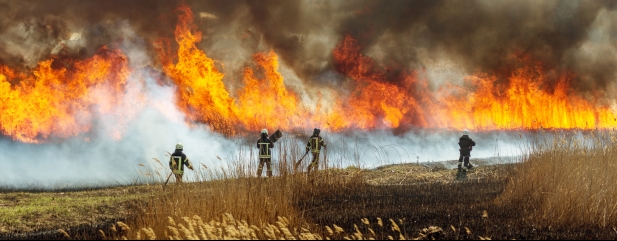Archived article
Please note that tax, investment, pension and ISA rules can change and the information and any views contained in this article may now be inaccurate.
Could climate change trigger a financial crisis?

As anyone who has been watching the news will know, droughts, wildfires and floods are no longer one-in-a-hundred-year or one-in-a thousand-year events, they are becoming more widespread, they are happening more regularly, and their effects are becoming more devastating.
California, Texas, New York, Switzerland, Spain, Italy, South Korea, China, Japan and Dubai have all experienced extreme weather events recently, with little or no warning, and the climate is becoming more unpredictable.
The UK isn’t exempt, either – a drought has been declared across Yorkshire after the driest spring since 1893 and the Scottish Fire and Rescue Service has warned of an extreme risk of wildfires this month after a 30,000-acre blaze in Perthshire.
So, could climate events contribute to the next financial market crisis?
‘THE FIFTH RISK’
As the world heats up, some countries are rolling back policies to combat global warming and energy companies are abandoning their promises to invest in renewables.
Meanwhile, the Trump administration is scaling down government agencies such as NOAA and FEMA (the Federal Emergency Management Agency), the bodies which prepare Americans for disasters and distribute aid.
In his 2018 book ‘The Fifth Risk’, author Michael Lewis warned of the dangers of a US administration responding to long-term problems with short-term solutions and ‘hollowing out’ the state agencies which quietly underpin everyone’s lives.
By dismantling agencies like NOAA (the National Oceanic and Atmospheric Administration) and FEMA (the Federal Emergency Management Agency), which respectively warn of disasters and manage the distribution of aid, the White House appears to some to be heading in this direction.
Of all the long-term problems facing the planet, climate change is perhaps the largest and the most difficult to solve and it is already having a direct impact on the insurance industry and the real estate sector in the US.
In June, the temperature topped 40C across a large swathe of the US as a ‘heat dome’ took hold across eastern and central states affecting tens of millions of people. This led to power emergencies as extreme temperatures put strain on the electricity grid.
According to NOAA, heat domes – which occur when a high-pressure system traps heat – and related atmospheric events behind extreme weather have almost tripled in strength and duration since the 1950s.
The problem is, heat domes and similar phenomena are difficult to forecast, and can happen at any time of year, but they are especially dangerous – and costly – during the summer.
Plus, forecasting where they might occur is just as hard as knowing when they might occur.
Take the example of Lytton, British Columbia, which in the summer of 2021 recorded temperatures as high as 49.6C before the town literally burned to the ground.
As Bloomberg’s Eric Roston explains: ‘When a team of climate scientists assembled days later to analyse the heat wave, they found the local historical weather data offered a paradox: their standard approach for estimating a heatwave rarity concluded the new records were too extreme to occur in the region where they did. They were, in a sense ‘impossible’, even though they actually occurred.’
COMPUTER SAYS ‘NO’
Due to the risk of wildfire, in some areas of the US, mainly Florida and California, insurance has not only become more expensive but fewer companies are willing to offer cover.
In January this year, the US Treasury’s Federal Insurance Office released a study of nearly 250 million policies issued between 2018 and 2022 which showed the average cost of premiums for people living in areas where climate-related risk was ‘high’ was over 80% more than in the least risky areas.
Those in high-risk areas also faced much greater likelihood of their insurer refusing to renew their policy, according to the FIO, whose role includes ‘monitoring the extent to which traditionally underserved communities and customers have access to affordable non-health insurance products’, making it another casualty of Trump’s agenda.
In another report, also issued in January, the US Financial Stability Board – which was set up following the global financial crisis to watch over the banking system – acknowledged climate-related vulnerabilities in the financial system, when triggered by climate shocks, ‘could threaten financial stability through various transmission channels and amplification mechanisms’.
The report went on to say, ‘These shocks raise concerns over financial institutions’ ability to manage their risks and to continue to provide financial services in certain segments and geographical areas’ as they can ‘interact with existing vulnerabilities in the real economy or in the financial system and threaten financial stability’.
A ‘STAGGERING’ LOSS IS COMING
In his final shareholder address, in February of this year, legendary investor Warren Buffett claimed that at some point the insurance industry – which includes Berkshire Hathaway (BRK.B:NYSE) – would face an outsized loss due to climate change.
Discussing insurance premiums, Buffett wrote that ‘pricing strengthened during 2024, reflecting a major increase in damage from convective storms. Climate change may have been announcing its arrival.’
While he admitted no ‘monster’ event had occurred during 2024, he warned: ‘Someday, any day, a truly staggering insurance loss will occur – and there is no guarantee that there will be only one per annum.’
It’s possible Buffett’s decision to hold off from buying stocks and build up significant cash reserves at Berkshire was a contingency against a big hit to the insurance business, which has historically provided the ‘float’ to the investment business.
While reinsurance prices rose during 2024, as they typically do after a year of heavy claims, they have been falling this year, which means there is a particularly keen focus in the industry on the coming US hurricane season.
TRILLION-DOLLAR DAMAGES
A study published in the journal Nature earlier this year forecast climate disasters could cost the global economy $38 trillion per year by 2050 compared with an estimated $417 billion in economic losses incurred by natural catastrophes last year.
At the same time, a report by the World Economic Forum in December 2024 titled ‘Business on the Edge’ forecast that any company which fails to adapt to climate risks like extreme heat – not just insurers – could lose up to 7% of their annual earnings by 2035.
‘Without resilience strategies, especially increasing heat will cause $560 billion to $610 billion in annual fixed asset losses for listed companies, with telecommunications, utilities and energy companies most vulnerable,’ warned the report.
Important information:
These articles are provided by Shares magazine which is published by AJ Bell Media, a part of AJ Bell. Shares is not written by AJ Bell.
Shares is provided for your general information and use and is not a personal recommendation to invest. It is not intended to be relied upon by you in making or not making any investment decisions. The investments referred to in these articles will not be suitable for all investors. If in doubt please seek appropriate independent financial advice.
Investors acting on the information in these articles do so at their own risk and AJ Bell Media and its staff do not accept liability for losses suffered by investors as a result of their investment decisions.
 magazine
magazine








